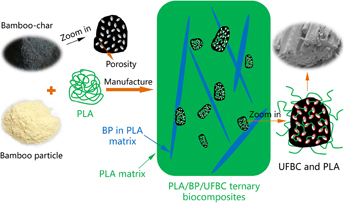Crossref Citations
This article has been cited by the following publications. This list is generated based on data provided by
Crossref.
Zhang, Qingfa
Cai, Hongzhen
Yi, Weiming
Lei, Hanwu
Liu, Haolu
Wang, Weihong
and
Ruan, Roger
2020.
Biocomposites from Organic Solid Wastes Derived Biochars: A Review.
Materials,
Vol. 13,
Issue. 18,
p.
3923.
Zhang, Qingfa
Lei, Hanwu
Cai, Hongzhen
Han, Xiangsheng
Lin, Xiaona
Qian, Moriko
Zhao, Yunfeng
Huo, Erguang
Villota, Elmar M.
and
Mateo, Wendy
2020.
Improvement on the properties of microcrystalline cellulose/polylactic acid composites by using activated biochar.
Journal of Cleaner Production,
Vol. 252,
Issue. ,
p.
119898.
Sainorudin, Muhammad Hanif
Abdullah, Nur Athirah
Asmal Rani, Mohd Saiful
Mohammad, Masita
Mahizan, Munirah
Shadan, Nursyazwani
Abd Kadir, Nurul Huda
Yaakob, Zahira
El-Denglawey, Adel
and
Alam, Mahboob
2021.
Structural characterization of microcrystalline and nanocrystalline cellulose from Ananas comosus L. leaves: Cytocompatibility and molecular docking studies.
Nanotechnology Reviews,
Vol. 10,
Issue. 1,
p.
793.
Khalid, Mohammad
Ratnam, Chantara Thevy
Wei, Shee Jia
Ketabchi, Mohammad Reza
Raju, Gunasunderi
Walvekar, Rashmi
and
Mubarak, Nabisab Mujawar
2021.
Effect of electron beam radiation on POLY(LACTIC acid) biocomposites reinforced with waste tea powder.
Radiation Physics and Chemistry,
Vol. 188,
Issue. ,
p.
109612.
Bartoli, Mattia
Arrigo, Rossella
Malucelli, Giulio
Tagliaferro, Alberto
and
Duraccio, Donatella
2022.
Recent Advances in Biochar Polymer Composites.
Polymers,
Vol. 14,
Issue. 12,
p.
2506.
Debnath, Kishore
and
Rao, Gorrepotu Surya
2022.
Bio-Fiber Reinforced Composite Materials.
p.
107.
Tian, Jiarong
Cao, Zhongqi
Qian, Shaoping
Xia, Yingbo
Zhang, Jiaxi
Kong, Yingqi
Sheng, Kuichuan
Zhang, Ying
Wan, Yi
and
Takahashi, Jun
2022.
Improving tensile strength and impact toughness of plasticized poly(lactic acid) biocomposites by incorporating nanofibrillated cellulose.
Nanotechnology Reviews,
Vol. 11,
Issue. 1,
p.
2469.
Vidal, Juliana L.
Yavitt, Benjamin M.
Wheeler, Mikhailey D.
Kolwich, Jennifer L.
Donovan, Lindsay N.
Sit, Clarissa S.
Hatzikiriakos, Savvas G.
Jalsa, Nigel K.
MacQuarrie, Stephanie L.
and
Kerton, Francesca M.
2022.
Biochar as a sustainable and renewable additive for the production of Poly(ε-caprolactone) composites.
Sustainable Chemistry and Pharmacy,
Vol. 25,
Issue. ,
p.
100586.
Prada, Alejandro
González, Rafael I.
Camarada, María B.
Allende, Sebastián
Torres, Alejandra
Sepúlveda, Javiera
Rojas-Nunez, Javier
and
Baltazar, Samuel E.
2022.
Nanoparticle Shape Influence over Poly(lactic acid) Barrier Properties by Molecular Dynamics Simulations.
ACS Omega,
Vol. 7,
Issue. 3,
p.
2583.
Wang, Yanen
Sultana, Jakiya
Rahman, Md Mazedur
Ahmed, Ammar
Azam, Ali
Mushtaq, Ray Tahir
and
Rehman, Mudassar
2022.
A Sustainable and Biodegradable Building Block: Review on Mechanical Properties of Bamboo Fibre Reinforced PLA Polymer Composites and Their Emerging Applications.
Fibers and Polymers,
Vol. 23,
Issue. 12,
p.
3317.
Guo, Zihao
Zhang, Shen
Liang, Yue
Zhang, Huanhuan
Qian, Xiangqun
Qian, Shaoping
and
Sheng, Kuichuan
2022.
Toughness Enhancement of Poly(lactic acid), Bamboo Particle and Ultrafine Bamboo-Char Ternary Biocomposites by Polyethylene Glycol Plasticization.
Journal of Polymers and the Environment,
Vol. 30,
Issue. 3,
p.
1162.
Xia, Yingbo
Qian, Shaoping
Zhang, Xu
Zhang, Zhaoyan
and
Zhu, Changfa
2024.
Biochar as an efficient reinforcing agent for poly(lactic acid)/poly(ε-caprolactone) biodegradable composites with high robustness and thermo-resistance.
Industrial Crops and Products,
Vol. 219,
Issue. ,
p.
119049.
B, Rajadurai
and
J, Chandradass
2024.
Mechanical, thermal, and morphological characterization of polylactic acid composites reinforced with coconut shell activated carbon.
Materials Research Express,
Vol. 11,
Issue. 11,
p.
115309.
Prasad, B. Sriram
and
Balaji, A.
2025.
Study on engineering properties of bamboo fiber/biochar reinforced epoxy composites rod.
Biomass Conversion and Biorefinery,
Vol. 15,
Issue. 1,
p.
1525.



